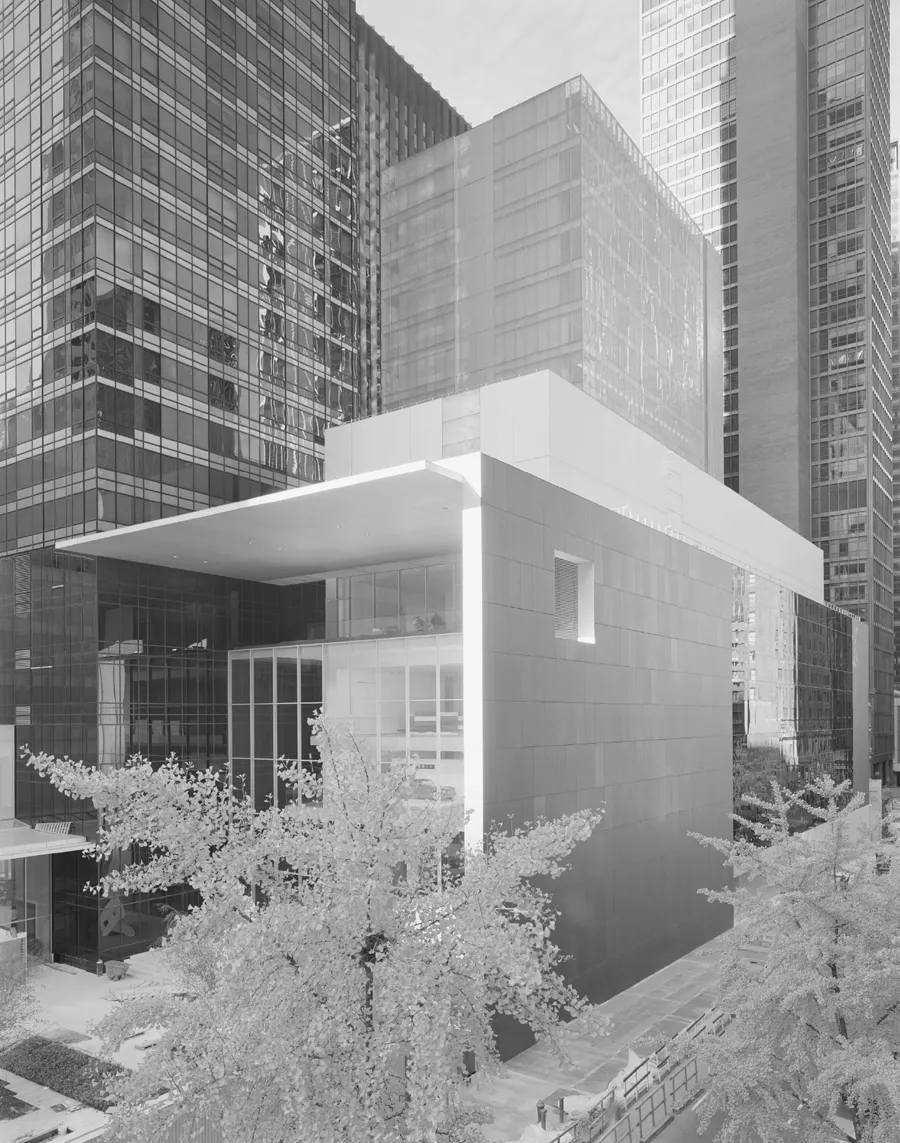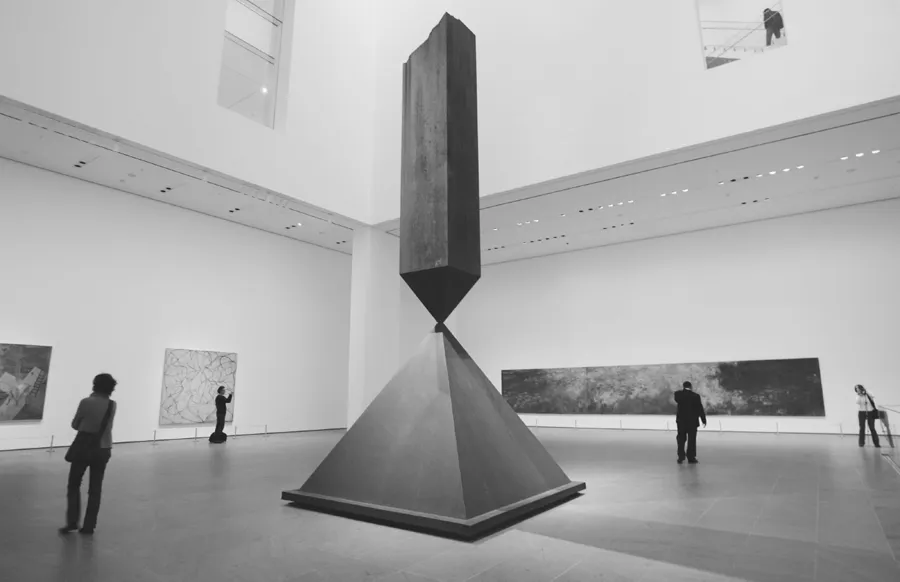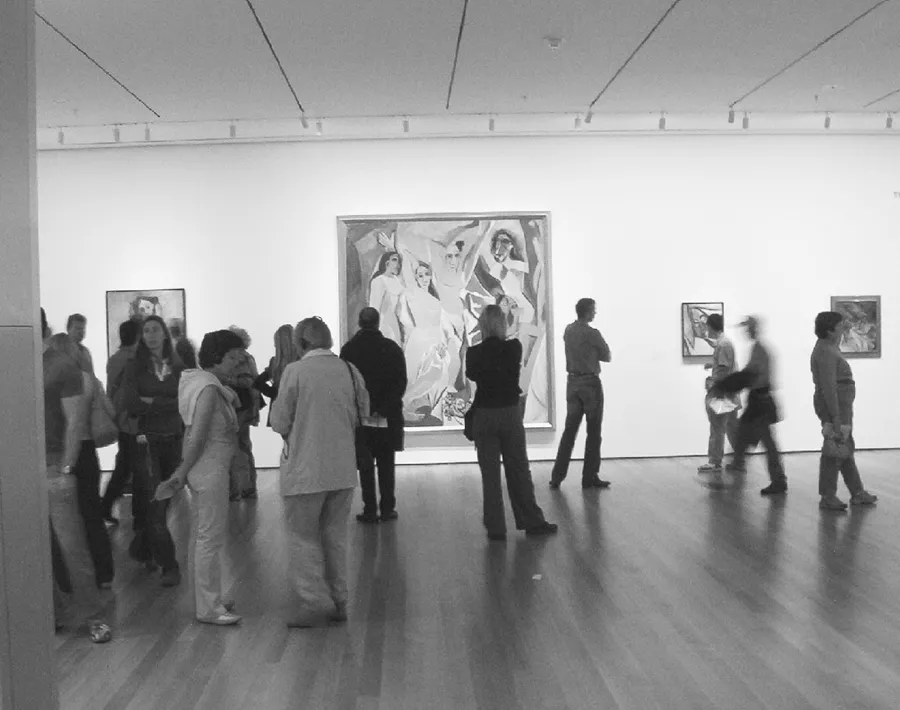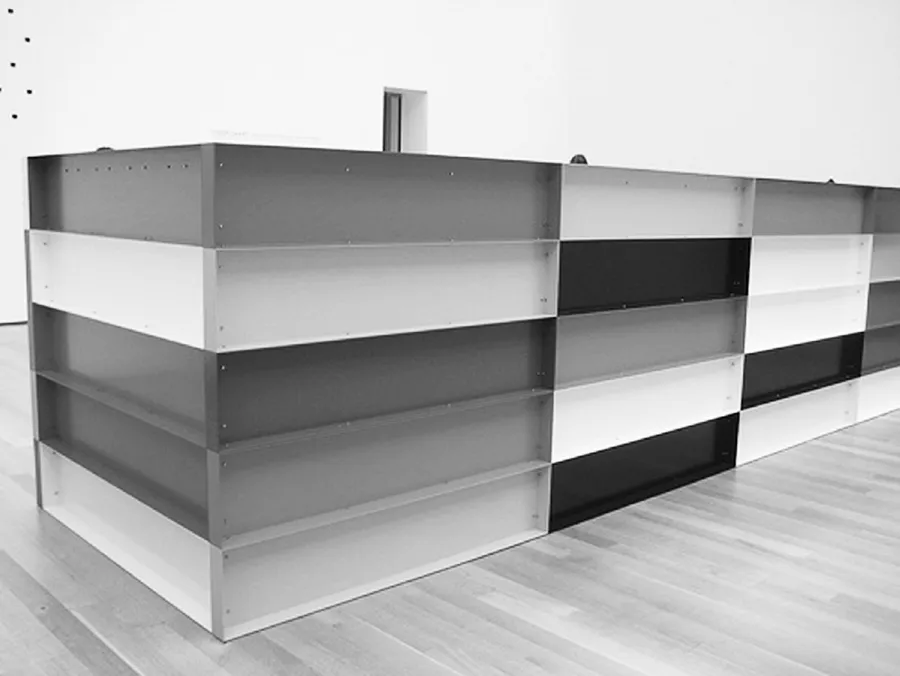![]()
Part 1
Museums: Modern / Contemporary
![]()
CHAPTER ONE
Remodernizing Manhattan
In the months leading up to November 2004, billboards all over the city of New York declared: “Manhattan is Modern Again.” Each featured a high viewpoint photograph of sunlight raking across an elegant International Style interior. The subscript explained the locus of this repeat modernization: “The new Museum of Modern Art reopens in Midtown on November 20.” It had been closed for four years to undergo a major rebuilding and expansion. MoMA’s long and careful campaign generated breathless publicity and secured a largely reverential art world response; it brought in twenty thousand visitors on day one and has racked up record attendances ever since. Given the jewels of early- and mid-century modernism that are the core of MoMA’s collection, nothing less was to be expected. But the reopening was not without its risks, for it exposed the museum—an institution of extraordinary art historical, cultural, even historical, significance—to some tough questions about its role and relevance in the twenty-first century, a time that seems to be shaping up to be modernity’s aftermath.
MoMA director Glenn Lowry justified the expansion as meeting pressing needs: to show more of the collection, to show it in a more open, less directive (read: historicist) manner, and to keep the museum alive by showing contemporary art. This agenda invites some questions. Does the architecture declare and enable a renewed vision of the museum? Are the historical collections better—more generously, less narrowly, more intelligently—displayed in the new, expanded spaces? Has the museum met the challenges of showing contemporary art in ways that might serve as models for museums elsewhere? My short answers are, respectively: not really, yes (mostly), no way.
Architect Yoshio Taniguchi is famous in Japan as the creator of deftly spaced, opened out art museums, mostly small in scale and in relatively isolated settings. He managed to achieve this effect even in his Gallery of Horyugi Treasures, a pavilion in the Tokyo National Museum complex.1 Midtown Manhattan is, of course, anything but isolated, and no friend to the small scale. Taniguchi’s undeniable achievement is the subtlety with which he has conjured the transparency of the block between 53rd and 54th streets and Fifth and Sixth avenues, revealing the multiple spaces inherent within the city’s grid structure. As an architectural fantasy about urban interiority, this is hard to beat. German photographer Michael Wesely evoked it precisely in his exposures of the museum as it was being built. These beguiling images were presented in the temporary exhibitions gallery on the sixth floor.
1.1. Yoshio Taniguchi, Museum of Modern Art, New York, renovation 2004. Sculpture garden and view of the David and Peggy Rockefeller building from West 53rd Street. (Photograph © Timothy Hursley. The Museum of Modern Art / Licensed by SCALA / Art Resource, NY.)
Transparency is achieved at the expense of MoMA maintaining a landmark look. Indeed, qua building, it has a scarcely visible externality, surrendering its own profile for a series of glimpses—as you approach along 53rd Street—of the museum’s previous architectural incarnations. The design sets itself deliberately against the paradigmatic success stories of spectacle culture. If Frank Gehry’s Guggenheim Museum at Bilbao seemed, when it opened in 1997, to be the pinnacle of destination architecture as art image, now, in the age of aftermath, reticence is the new excess. News media homed in on Taniguchi’s remark to the trustees: “Give me your millions, and I will make you an outstanding museum. Give me more and I will make it disappear.” This is, if we were to take it literally, an extremely literal response to the crisis of the museum of modern art in the age of the contemporary, after the advent of contemporary art. Yet spectacle values are alive and well in such seemingly modest intentions. The architect presents himself as an illusionist of ever more expensive refinement. He seems to say: if you permit me to make $858 million (actually $425 million in construction costs) evaporate before everyone’s eyes, we will trump those who have made tangled wastage the iconic sign of elevated culture, because we will have rendered massive consumption inconspicuous. While this is hardly a new move in the internecine warfare of upper-class culture, it is a magical, up-to-date one nonetheless.
These considerations may not have been uppermost in the minds of those in the long queues who waited over two hours for entry. Subtlety does appear to its best advantage in the invitation to begin your experience of the museum in the enlarged Sculpture Garden, making this early 1950s refuge a welcome sight. Rodin’s magisterial bronze Monument to Balzac does the inviting. The garden affords the best views of the subtleties of the renovation and is the best recipient of them from the inside.
Next, you ascend the stairs to the second floor, to be uplifted by a huge new space, a vast rectangular atrium that extends 110 feet to skylight monitors. Sections of its walls are cut out to serve as doors to lower galleries and to reveal glimpses of upper galleries fed by skyline walkways. Refinement quietly underscores this great space. Few visitors consciously notice the thin, dark strip that sets back the point where wall meets floor, adding lightness to the great expanse of wall. The same effect is generated by the same means throughout the museum. So, this is where much of that money went!
1.2. Yoshio Taniguchi, Museum of Modern Art, New York, renovation 2004. Atrium showing Barnett Newman, Broken Obelisk, 1963–69. Cor-Ten steel. (Photograph © Mario Tama / Getty Images.)
The atrium is nailed down at its center by Barnett Newman’s Broken Obelisk—reprising the welcoming gesture made by another edition of this sculpture outside the Rothko Chapel in Houston. Although Newman’s work is one of the few in the collection that could survive in such a space, it establishes immediately a double message: modern art is iconoclastic—see how we endorse the artist’s attack on classicism—but don’t you love how he does it—such élan, such risky solidity, such authority, so modern, yet already a classic. Here we are. And there you are. Passing each other, comfortably, en route to the next art excitement. To me, this kind of messaging gets too close to a themed fountain in a shopping mall.
Which is what the basic design concept soon turns out to be. For all its beauties, and despite its refusal to be the apse of a Cathedral of Contemporary Art (the ambition of the atrium at the Guggenheim, Bilbao), this great well is a dispenser of crowds into the galleries that cluster off it. It deploys a heady mixture of disorientation and directedness that typifies the postmodern foyer. We could, for example, stay in this space and satisfy ourselves with seeing the great Water Lilies by Claude Monet reduced to an emblem of the impressionism that, we will soon learn, precedes modern art. We could skim over the large, bland paintings by Willem de Kooning, Jasper Johns, and Brice Marden on the main wall, reading them as signals of the proximity of contemporary art. And move smartly on to the restaurant or café.
At which point, the building asks those who wish to actually look at the art in it to make a choice among four options: stay on this level and enter the contemporary galleries; head for the escalators and enter one after another of the smaller curatorial departments (drawings and printed books, architecture and design, photography, or film); take the elevators to the fifth floor, cross a suspended bridge and enter the painting and sculpture department’s post-impressionist galleries; or go to the sixth floor for the huge temporary exhibition gallery. As a matter of experience, this sounds clearer than it actually is. The printed guides picture each floor as roughly equivalent in their offerings, which they are not, and are misleading as maps. Repeat visitors will not need them, but bug-eyed crowds will just follow the flow, cross and re-cross their paths, as at a multiplex on the weekend.
New York Times architecture critic Nicolai Ouroussoff had no doubt that visitors would get the messages that great modern art has to be sought out, and that it exists in a pure form in the fifth and fourth floor galleries. Up there, it sits at the apex of a hierarchy of artistic achievement, at a level to which more recent art can only aspire. Taniguchi’s design, he recognizes, is “an overwhelming assertion of control, beautiful but chilling.” It underscores “what powerful art institutions do: they set standards, they make evaluations.”2
Alternatively, the design can be seen as an outcome of a program dominated by the territorialism of MoMA’s curatorial departments. Medium overspecificity has pervaded the museum’s history, generating its greatest achievements (outstanding special exhibitions, authoritative historical hangs) and its most abject shortcomings (academic conservatism, caution toward the contemporary). The new building miniaturizes and monumentalizes both. Each departmental section tells the same century-long story of internal questioning (European, mainly Parisian) leading to an embattled confidence (American, mainly New York in style). Each does so in the absence of examples of the academic, conventional and, with exceptions, mass / commercial / pop cultural oppositions over which modern art did triumph. But each section does so at a different scale, scope, and depth, and in a distinct, hard-to-reach part of the museum, with the result that the sameness of the story becomes porous, and all but vanishes as it approaches the present. This is of course what actually happened during the 1960s, when reductive definitions of each artistic medium provoked a reaction that expanded the scope of them all. MoMA, however, cannot bring itself to contain its internal organization behind the scenes. It must be paraded front of house, with confusing results—especially when we come to recent decades, to which I will return.
If we take the elevators to the fifth floor, we do so in eager anticipation of seeing those masterworks of painting and sculpture that have come, through insistent repetition, to define modern art for generations of art lovers. Which ones will be there? What will be their arrangement? It is a relief to find the classics all there, interesting that some have moved into new places in the story, and a delight that they have been joined by more of their companions, as well as by works from long-ignored yet parallel traditions, especially those in South America. Nevertheless, for all the extra room (a 50 percent increase in exhibition space), these changes come across as tentative variations.
The displacement of Cézanne’s Bather (ca. 1890) from its position of first painting to be seen—a status it had held for decades—and its replacement by Signac’s Against the Enamel of a Background Rhythmic with Beats and Angles, Tones and Colors, Portrait of M. Félix Fénéon in 1890 attracted much comment among first responses to the re-hang. Conjuring the figure of Fénéon as an art illusionist is a witty way of welcoming the public into the magic kingdom of modern art. This move enables a wider range of Cézannes to be hung and allows us to see the Bather as a more awkward, ambiguous painting, as an image about what it is like to hover on the edges of manhood. This first room has none of the force of moving through the rotunda of the Philadelphia Museum of Art, where one is able to see in quick succession consummate paintings of bathers by Renoir, Cézanne, and Degas, all made late in their careers.3
Crowds knot in front of the Van Goghs in the second room, especially the much-reproduced The Starry Night. On the opposite wall is our first taste of color painting, Matisse at Colliure, and Derain’s early boldness. Fauvist and cubist strains play out in the rooms devoted to the futurists and the expressionists, until one enters the superb room devoted to Matisse, which features icons such as The Red Studio alongside ravishing recent acquisitions like The Yellow Curtain (1915). This room surpasses those in which Matisse features at the Musée d’Orsay, matches the display at the Barnes Foundation in Merion, Pennsylvania, and is surpassed only at the Hermitage (or would be, if all the works by Matisse in St. Petersburg were brought together).
1.3. Museum of Modern Art, New York, modern art collection room, reopening 2004. (Photograph by Chris Ashley, 2005 [http://chrisashley.net/].)
It will always be wonderful to see what Picasso did to European, especially French, painting in the first two decades of the twentieth century. Wielding the visual coding of “the primitive,” he suffused painting with the strangeness of Spanish outsider art, and thus rendered it forever provisional. While the Demoiselles d’Avignon is an almost brutal demonstration of this new power, you can see it most poignantly in an adjacent small room of analytic cubist works: as it impacts on Braque, who offers exquisite supplication in return. Stronger Braques from the period, of which there are many, would make a different point.
Overall, these early rooms repeat the museum’s highly conventional narrative of modern painting (nailed into place by long-serving curator William Rubin) as a multivalent struggle between Matisse’s color harmonies and Picasso’s trenchant line. Kandinsky is pinioned by this barrage, as are the futurists. This tug of war is picked up on the floor below by the juxtaposition of Pollock and Newman and echoes through to the 1960s, where it is absorbed into the work of single artists, such as Rauschenberg, is played out in Warhol’s series screen paintings—and, we discover to our astonishment, in the high contrast coloring of the stacked I-beams of Donald Judd’s Untitled (1989), which occupies a major external landing.
1.4. Donald Judd, Untitled, 1989. Museum of Modern Art, New York, contemporary art collection, reopening 2004. (Photograph by Joe Roumeliotis. The Museum of Modern Art, NY. © Judd Foundation. Licensed by VAGA, New York, NY.)
Along the way there are some outstanding concentrations. From behind a screen you are surprised by a stand of Brancusi sculptures that look as forceful as any showing of his work can, outside of the recreation of his studio on the grounds of the Centre Pompidou. In the room devoted to Duchamp and Russian art, medium divisiveness relaxes for a moment, and collage consciousness gets its (too brief) moment of glory. In this room there is, as well, a terrific wall that reads back and forth across Malevich’s White on White, key works by Rodchenko and Klucis through to El Lissitzky’s supremely subtle Proun 19 D (1922). (Project for the Affirmation of the New, indeed!)
Piet Mondrian is well memorialized, culminating in his hybrid homage Broadway Boogie-Woogie. Picasso and Bonnard reclaim the 1920s in their contrasting visions of their respective spouses: benign grotesqueries face off against quietly glowing self-effacement. Through these rooms the welcome additions appear: Joaquín Torres-Garcia (but nothing from the Madí group), a selection from the Migration series by Jacob Lawrence, Agrarian Leader Zapata by Diego Rivera, and David Alfaro Siqueiros’s haunting Collective Suicide (1936), a nightmarish vision of organized society perpetrating—through its drive into lynching and fascism—a Last Judgment upon itself. What a prefiguration this is of a crucial turning point painting hung one floor below: Pollock’s Number 1A, 1948. As you leave thes...




